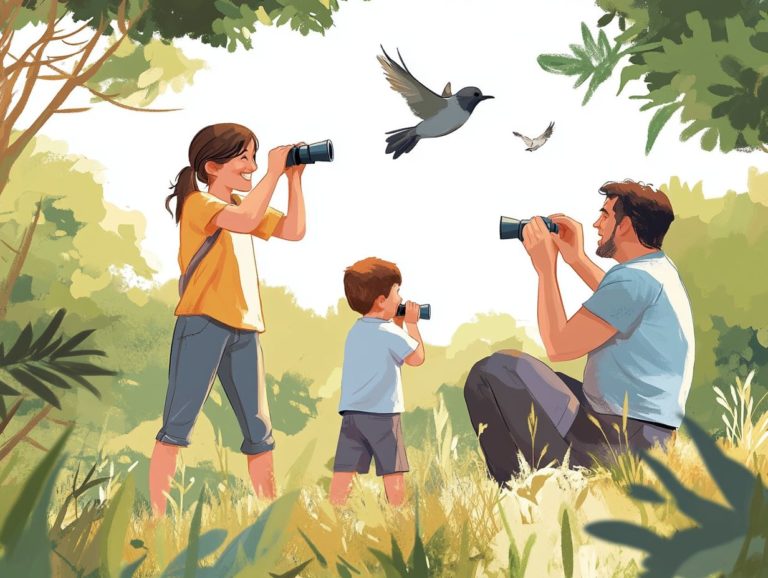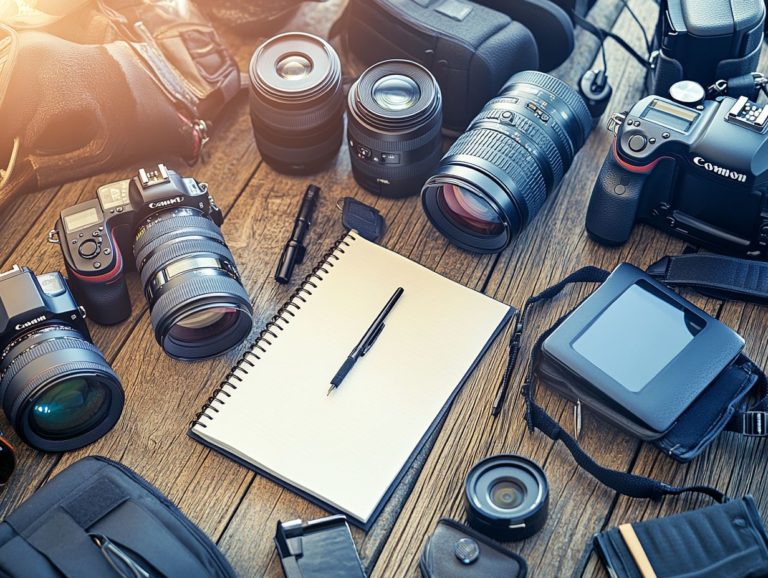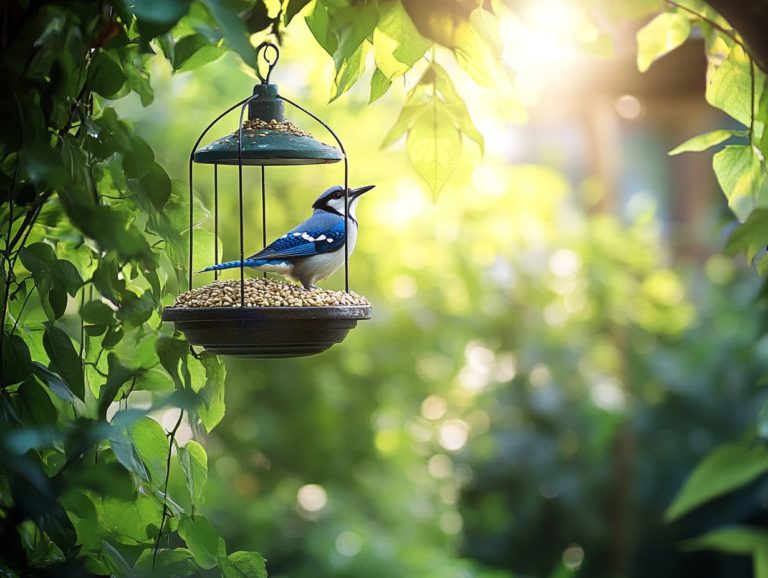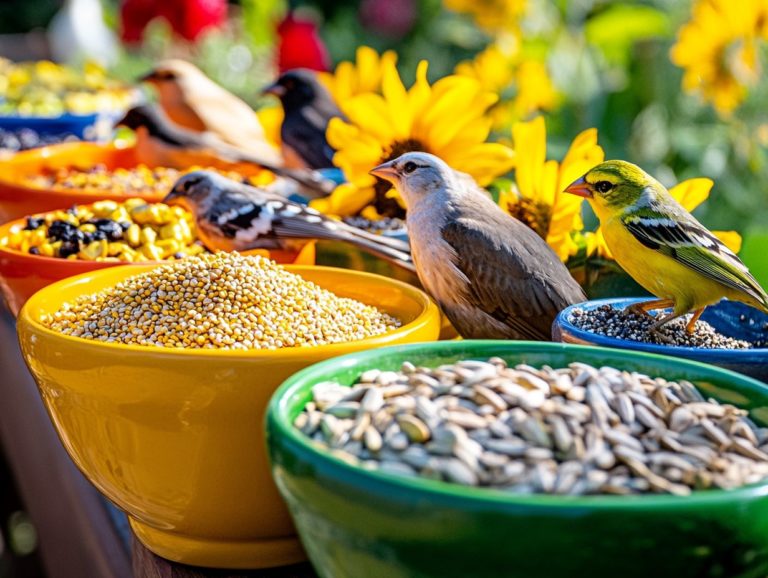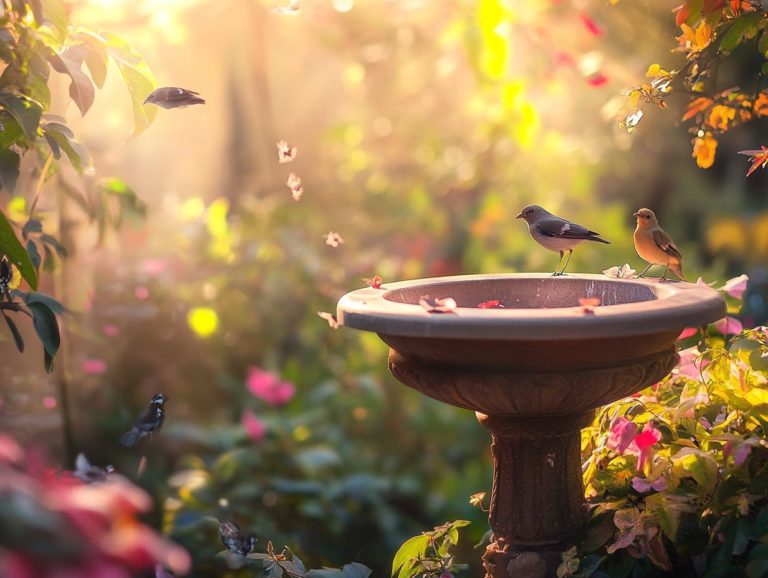6 Essential Bird Watching Skills for Every Enthusiast
Bird watching is an exciting adventure that connects you with nature and goes beyond a simple pastime. Whether you are an experienced bird enthusiast or just starting to explore this thrilling hobby, developing specific skills will elevate your experience.
You will discover six essential skills every bird watcher should master:
- Understanding bird behavior and calls
- Patience
- Attention to detail
- Knowledge of bird species and their characteristics
Find practical tips on how to get started, the necessary tools, such as binoculars for closer views, a field guide for identification, and a notebook for your observations. Learn ways to contribute to bird conservation. Get ready to elevate your birding adventure now!
Contents
- Key Takeaways:
- 1. Patience and Persistence
- 2. Observation and Attention to Detail
- 3. Knowledge of Bird Behavior and Habits
- 4. Familiarity with Bird Calls and Songs
- 5. Proper Use of Binoculars and Other Birding Equipment
- 6. Understanding Birding Ethics and Conservation
- How to Get Started with Bird Watching?
- Frequently Asked Questions
- What are the 6 essential bird watching skills for every enthusiast?
- Why is field identification important for bird watching?
- How can I improve my bird call and song recognition skills?
- What is the significance of recognizing different bird habitats?
- Do I need special equipment for bird watching?
- How can I keep track of my bird sightings?
Key Takeaways:
- Master patience and persistence to spot hard-to-find birds.
- Sharpen your observation skills to identify different bird species and their migration patterns.
- Enhance your experience by knowing bird behavior and their unique calls.
1. Patience and Persistence
Bird watching is an exhilarating yet challenging outdoor activity that requires both patience and persistence. Enthusiasts often spend long hours quietly waiting to observe various bird species and their unique behaviors in natural settings. This careful waiting significantly increases your chances of meaningful sightings, as many birds tend to be shy and cautious.
For example, a keen observer may find greater success by returning regularly to the same location. This allows them to learn the daily patterns of local birds, including their feeding and nesting habits.
Using diverse birding equipment—like binoculars, spotting scopes, or mobile apps for bird identification—can greatly enhance your experience. These tools help you spot distant species and aid in documenting sightings, transforming each excursion into an inspiring adventure and a valuable contribution to conservation efforts.
2. Observation and Attention to Detail
You need to observe carefully while bird watching to identify various species based on their physical attributes and behaviors. Field guides and smartphone applications, such as Merlin Bird ID and the Audubon Bird Guide, assist in this process by helping you identify species even in challenging conditions.
These resources provide detailed descriptions and images, often featuring interactive tools to help you narrow your search based on size, color, and habitat. Bird calls also play a crucial role in identification; even when birds are hidden, their unique sounds offer important clues about the species in the area.
Enhancing your listening skills can make bird watching a much richer experience.
3. Knowledge of Bird Behavior and Habits
Understanding bird behavior and habits is essential for any bird watcher. It enables you to anticipate migration, feeding, and nesting patterns in various bird species. By observing how different species respond to seasonal changes, such as food availability and temperature shifts, you can enrich your overall experience.
For instance, the migration of warblers often coincides with the budding of trees, providing an exciting opportunity to see these birds feeding on insects. Additionally, certain mating displays, like the elaborate courtship dances of peacocks, are influenced by factors such as the number of daylight hours and weather conditions.
Familiarity with these behaviors enhances your bird-watching experience, transforming it from simple observation into a deeper appreciation of nature.
4. Familiarity with Bird Calls and Songs
Understanding the calls and songs of birds enhances the birdwatching experience. Many enthusiasts can recognize birds by sound alone, even when they are not visible.
When individuals know bird calls, they often feel more excitement during rare sightings. They also gain deeper insights into the behavior and habitat of birds.
This knowledge helps them identify various calls, such as warning calls, mating calls, and playful interaction calls.
For those looking to improve their ability to recognize birds by sound, smartphone apps can be incredibly helpful. These apps offer audio samples along with photo guides, allowing both novice and experienced birdwatchers to learn and practice.
5. Proper Use of Binoculars and Other Birding Equipment
Having the right bird-watching equipment is essential for an optimal experience. Good lens quality improves visibility when observing birds in their natural habitat.
Before diving into types of binoculars, understand the differences between the designs. There are two main types: Porro prisms, which are wider and bulkier, and roof prisms, which are compact and streamlined.
Binoculars with a magnification of 8x to 10x are ideal for birdwatchers. They strike a balance between image clarity and stability at longer distances.
Lightweight designs are preferable for easy transportation over long distances. Supportive hiking shoes are crucial for navigating varied terrain, and a waterproof jacket is necessary for changing weather.
Other useful equipment includes:
- Camping chairs
- Field journals
These items provide vital support for birdwatchers.
6. Understanding Birding Ethics and Conservation
Birding ethics and conservation principles are vital for responsible birdwatching. They ensure that the practice does not harm or exploit birds and their habitats.
- Respect for Birds and Their Habitats: Birdwatchers should maintain a safe distance to minimize stress and disturbance.
- Observing Nesting Birds: Birdwatchers must recognize the dangers of approaching nests, especially during breeding seasons, as this can impact bird populations.
- Contributing to Conservation Culture: Citizen science helps collect valuable data for research and conservation. This involvement is critical for protecting endangered species.
- Providing for Local Bird Life: Birdwatchers can help local species by installing bird feeders and birdhouses. These additions provide vital food and shelter.
How to Get Started with Bird Watching?
Get ready for an exciting journey! Bird watching is a thrilling hobby that requires a few essential tools and a curious spirit.
To get started, acquire the right equipment. Quality binoculars are crucial for observing birds from a distance.
Sturdy hiking boots make exploring varied terrain enjoyable. A reliable field guide specific to your region is also invaluable for identifying species.
Smartphone apps like eBird are essential for tracking bird sightings. These apps allow users to log their observations and contribute to citizen science, enhancing the experience.
What Are the Essential Tools for Bird Watching?
Key tools for bird watching are binoculars, field guides, and smartphone apps. These help you identify birds and keep a record of your sightings.
The ideal binoculars for bird watching typically have a magnification of 8x to 10x and a large objective lens diameter. This ensures bright and clear images even in low light conditions. Features like waterproofing and rubber armor enhance the durability of binoculars, making them suitable for various environments.
A field guide is another crucial tool for bird watchers. It aids in identifying different species and understanding their habits. Many bird watchers also utilize smartphone apps like Merlin Bird ID or eBird. These apps provide identification tools with extensive databases and allow users to track and log their bird sightings, creating a permanent record of their bird-watching experiences.
How Can One Improve Their Bird Identification Skills?
Here are several ways to enhance your bird identification skills:
- Read field guides to learn about various bird species.
- Utilize smartphone apps like Merlin Bird ID and the Audubon Bird Guide for bird watching.
- Practice recognizing bird calls and studying bird behavior to distinguish their features.
- Engage with local birdwatching groups or participate in citizen science initiatives to learn from others.
- Use audio guides and bird identification apps to help identify birds by sound.
- Maintain a field journal or notebook to track your observations and progress while bird watching.
What Are the Best Places for Bird Watching?
The best locations for bird watching encompass diverse ecosystems and opportunities for various outdoor activities like hiking and camping. Areas such as wetlands, forests, and grasslands support different bird species. The richness of species is greater in regions where these habitats are found in proximity to one another.
For instance, wetlands like the Everglades in Florida offer a rich habitat and a variety of bird species. You can spot herons, egrets, and many migratory birds. Similarly, forests, such as those in Maine—especially in Acadia National Park—provide birdwatchers with opportunities to see songbirds and raptors. Grasslands, like those in Nebraska’s Sandhills, showcase unique avian species, including the greater prairie chicken.
Seasonality plays a significant role in observing migration patterns and bird visibility. Especially during migration seasons in spring and fall, birders can see flocks preparing for their journeys.
How Can One Contribute to Bird Conservation Efforts?
You can help bird conservation by participating in citizen science. Installing bird feeders and birdhouses also supports local bird populations. Your impact is amplified when you report your sightings to databases like eBird, which track bird distributions and populations over time. This data is vital for researchers and conservationists.
Additionally, consider volunteering with local conservation groups. You can assist with habitat restoration or educational programs. Implementing sustainable practices, such as maintaining native plants in gardens, creates healthier environments for birds.
What Are the Common Challenges Faced by Bird Watchers?
Bird watchers often encounter several common challenges, including harsh environmental conditions and the need for supportive footwear to enhance comfort, difficulty in spotting species, and the need for improved skills and techniques.
Inclement weather, such as rain or strong winds, can significantly hinder visibility and overall enjoyment of outdoor activities and bird activity. To address these challenges, bird watchers should wear appropriate clothing, including a waterproof jacket, and ensure they have waterproof gear and protective covers for their equipment.
Loud noises can scare birds away, so it’s important to maintain a low volume when speaking and select locations that are remote from busy streets, trails, and high-traffic areas. Enjoying a camping chair can also add to your convenience.
Acquiring knowledge about bird behavior can enhance sightings, as different species and groups of birds are active at various times of the day and year, particularly when enjoying snacks like trail mix. Moreover, birds tend to be more active at the onset of different weather conditions.
Frequently Asked Questions
What are the 6 essential bird watching skills for every enthusiast?
The 6 essential bird watching skills for every enthusiast are field identification, recognizing bird calls and songs, habitat recognition, using binoculars and spotting scopes, outdoor skills, and record keeping.
Why is field identification important for bird watching?
Field identification is important for bird watching because it allows you to distinguish between different bird species and accurately record your sightings. It also helps you understand the birds’ behavior and habitat preferences.
How can I improve my bird call and song recognition skills?
You can improve your bird call and song recognition skills by listening to recordings of bird calls, practicing in the field, and joining local birding groups where you can learn from experienced bird watchers.
What is the significance of recognizing different bird habitats?
Recognizing different bird habitats is crucial for successful bird watching, as different species have specific habitat preferences. Knowing the typical habitats of certain birds can help you locate and identify them more easily, especially with the aid of binoculars and bird identification apps.
Do I need special equipment for bird watching?
While not necessary, having a good pair of binoculars and a spotting scope can greatly enhance your bird watching experience. They allow you to see birds from a distance and observe their behavior more closely.
How can I keep track of my bird sightings?
You can keep track of your bird sightings by recording them in a field journal or using a birding app. This helps you keep a log of the birds you have seen and their specific details, such as location and behavior.

